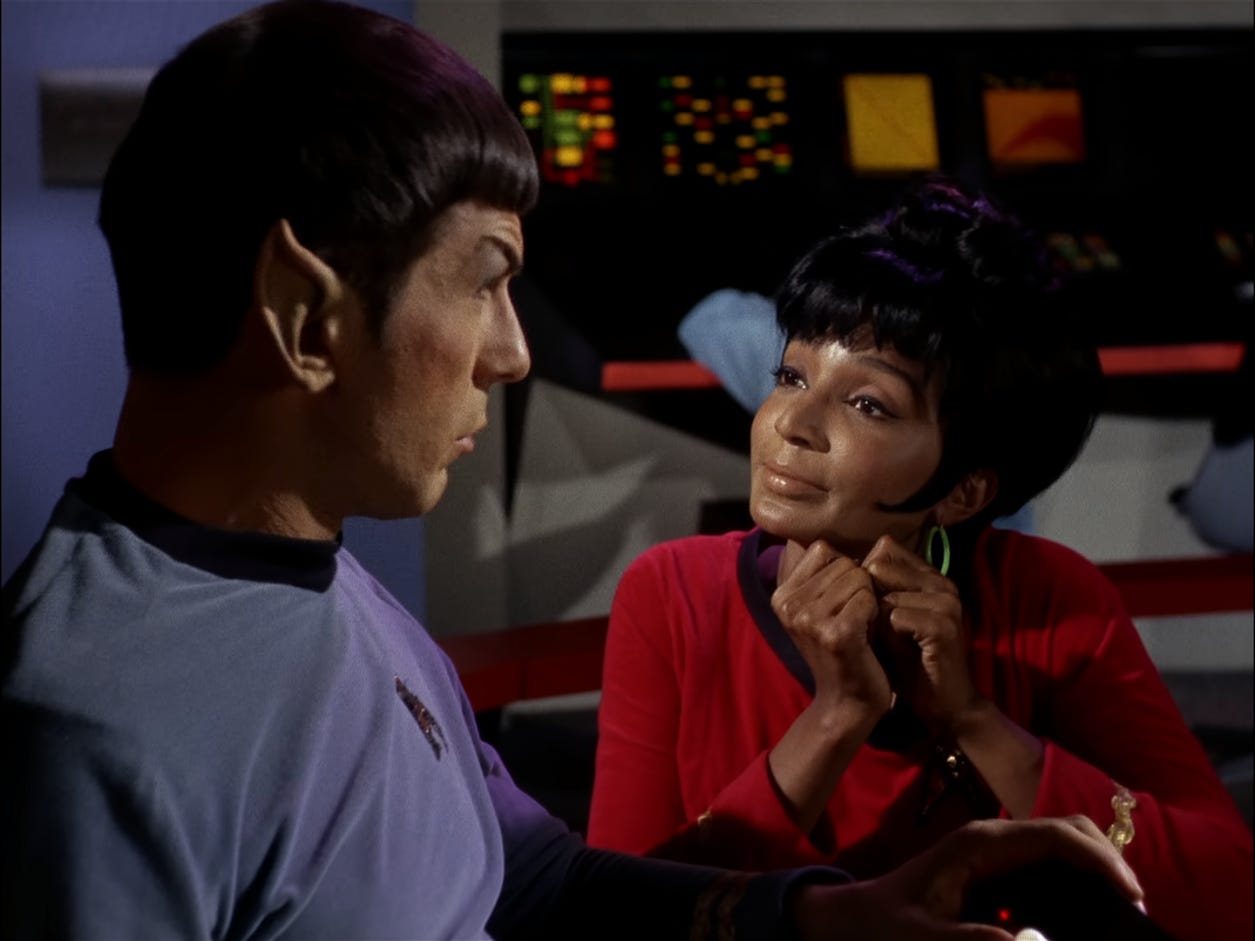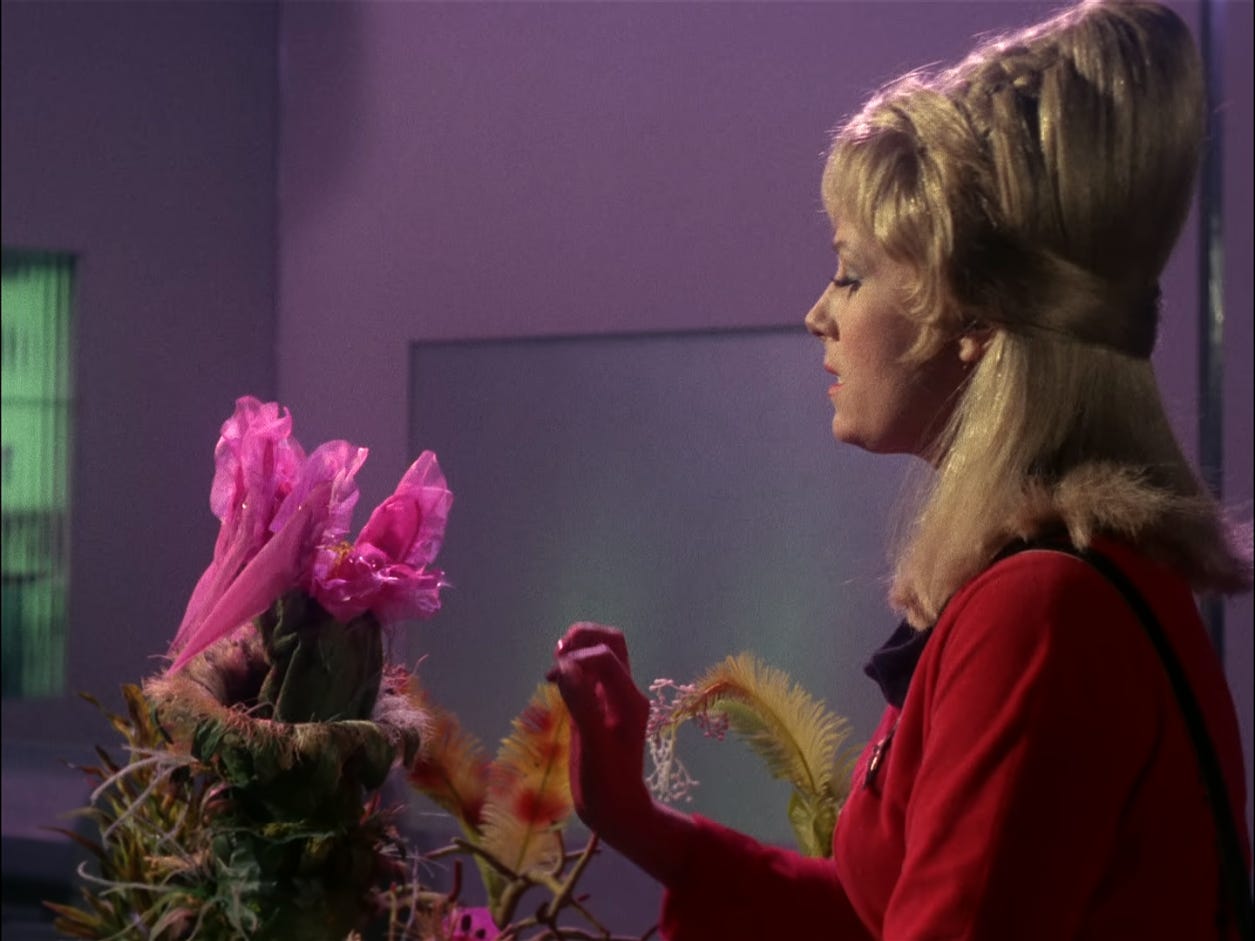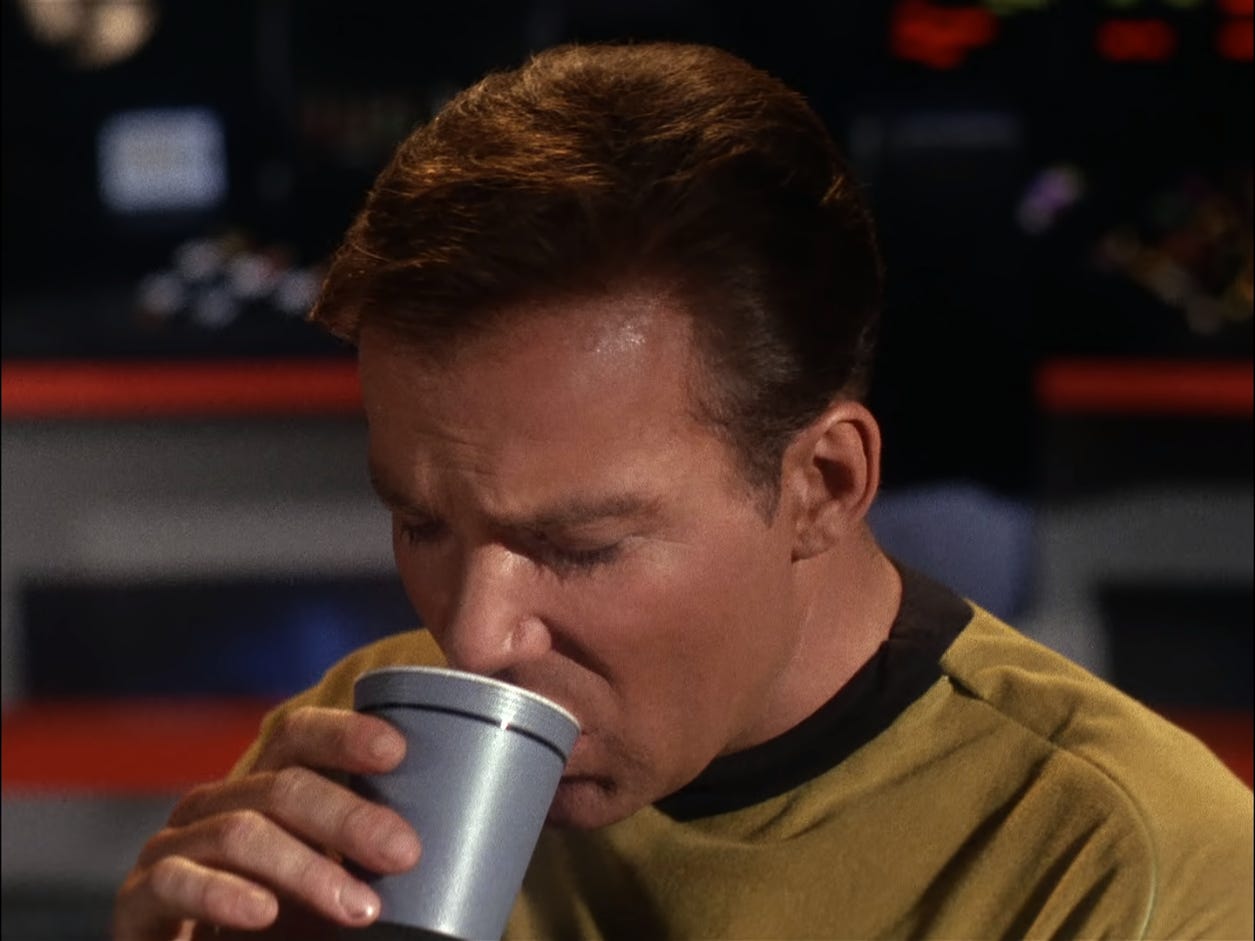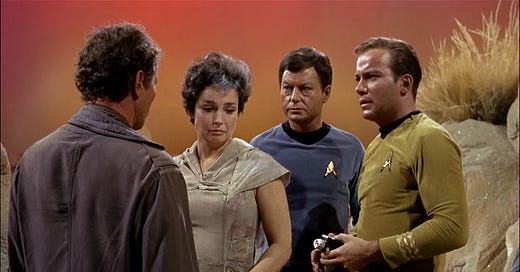
Star Trek, S1E1: “The Man Trap” TOS episode 1 of 80 Original air date: 6 September 1966 Stardate: 1513.1 (2266 CE) Notable guest stars: Jeanne Bal as Nancy Crater / the salt vampire
The first episode of Star Trek (the original series) aired on 6 September 1966 on the Canadian network CTV. Two days later, NBC — which had commissioned the series — aired it in the US. As far as first episodes go, “The Man Trap” is a somewhat awkward start to the series, but it must have made a profound impact on viewers at the time. And the decision, made based on the horror-oriented plot of the episode, to air it as the series’ debut (“The Man Trap” was the sixth episode of the series to be filmed) obviously paid off, as it won the ratings battle within its timeslot.
“Mr Spock, outfit a landing party. We’re beaming down with some questions.”
For this review, I watched the remastered version of the episode available on Netflix in Germany.
One Big Cold Open
“The Man Trap” does not work at all as a pilot episode to a TV show. Which is not surprising, since it never was intended as a pilot. The first pilot, “The Cage”, was rejected and the second one, “Where No Man Has Gone Before”, was aired third in the sequence of the show. The whole episode serves as one big cold open to the entire series. None of the characters are introduced and we have little idea of what mission the U.S.S. Enterprise is on — or for whom. We see an alien planet full of ruins and Kirk tells us that “one of the missions of the Enterprise is to protect human life in places like this”, but not much more.
We also learn that the ship is hauling Mexican chili peppers Kirk apparently hand-picked himself for a “space commander” at some kind of “starship base”. But that is all. Other than that, we only have the interaction between characters to go on, as they appear for the first time. But we’re not even told the most basic things, like the fact that Spock is the first officer of the ship.

That being said, what we’re shown must have made quite the impression on audiences in 1966. Maybe specifically because it was such a cold open. Or simply because of the visuals. Or maybe because the show was so different. The planet, while standard barren TOS fare with tumbleweed-like vegetation throughout, sports a stunning tequila sunrise sky. As far as visual effects go, this must have been the state of the art back then. An impressive result, especially when considering how tight the budget for the first season of TOS was.
A Friendship for the Ages
The episode actually opens with Spock in the captain’s chair on the bridge, but we quickly switch to Kirk and McCoy on the planet. These early scenes between Kirk and Bones establish their friendship, and differences, quite nicely. These scenes are acted pretty well, especially considering some of the more ham-fisted performances the series is famous for. Kirk is quite playful at times, teasing McCoy about how he’s still clearly in love with Nancy Crater, one of the two scientists living on the planet whom they’ve come to visit, and how his perception is obviously clouded by this.
At the very end of the first act, Kirk turns more forceful and almost flies into a rage when he and Bones discover that one of the Enterprise crewmen has been murdered. This quickly establishes a quite intense personality to Kirk that is very much at odds with pretty much every other Starfleet captain we meet in the later shows. It almost becomes an in-joke, and by the time DS9 comes around, Kirk has become notorious for his impulsive manner and sometimes reckless antics. “Those very different, wilder times back then” will run the often-echoed sentiment.

Kirk has a good reason for his outbreak, though: He takes the lives of his crew very seriously. As a good Starfleet captain should. And he makes up for his impulsive outbreak later on, as Bones confesses he might have messed up: “Another error on my part.” Kirk gives him a shit-eating and replies: “I’m not counting them, Bones.” Here, in the very first episode, we see clearly why Kirk is such a good leader of men. He’s firm when he needs to, but never resentful or petty. And Shatner has the charisma to pull it off believably, too.
Period Piece
Back on the bridge, Spock and Uhura have their own introductory scene. It is well acted, but marred by a streak of obvious disrespect for female characters that runs through the whole episode. While quite normal for 1966, when looked at while applying today’s standards, this dialogue is quite jarring. Star Trek as a franchise has always had a reputation of inclusiveness and tolerance, starting with the original series, and the fact that a black actress has such a prominent role in the first episode is a testament to this, but the show at this point is clearly lacking when it comes to treating women as equal to men.
In an even worse scene, Professor Crater tells Kirk: “It’s different for me, I enjoy solitude. But for a woman … you understand, of course …” Back in 1966 audiences probably did. Today, a nonsensical statement like this is quite revolting. This whole situation is not improved by Jeanne Bal having to play the stereotypical hysterical woman upon (allegedly) discovering the corpse of Crewman Darnell. Her acting isn’t the best in general either, but I wonder if that might not have been required by the script. She’s just an alien masquerading as a human, after all.

On the bridge, Uhura — who calls herself “an illogical woman” three sentences into her first outing on screen — clearly does not understand the specific relationship Vulcans have with emotions. Nor does the viewer at this point. Even today, watching this scene, I am not quite sure if Uhura is actually flirting clumsily with Spock or if she’s just trying to wind him up. Seeing as she doesn’t seem to understand the peculiarities of his species, the former seems more likely. Be it as it may, the obvious sexual stereotypes displayed by Uhura’s character make the whole scene quite off-putting. It’s so uncomfortable, in fact, that even Spock is pulling at his collar as if getting hot.
“You could learn something from Mr Spock, Doctor. Stop thinking with your glands.”
Leaving the period-specific bigotry aside, this scene at least gives us one very memorable piece of dialogue, as Uhura asks Spock to give her a romantic impression of his home world with the moon high in the sky, and Spock replies in that amazing deadpan that only Leonard Nimoy could deliver: “Vulcan has no moon, Miss Uhura.” To which Uhura says, quite sarcastically: “I’m not surprised, Mr Spock.” This exchange is very reminiscent of Kirk’s recurring teasing of Spock in later episodes.
Space Western
At the very beginning of its life, the show leans hard into the space western theme that gave it its title. This is very apparent in the frontier look of the planet itself, Crater’s base and the implied archaeological dig sites. The early holsters for the phasers are definitely inspired by westerns and the crew is also wearing proper, full-length boots with their uniforms. And then all the talk of buffalo …
At one point, Professor Crater, who is really resistant to getting a mandatory health check by Starfleet and obviously values his privacy, calls Kirk a trespasser on his planet. He actually seems to feel like the whole of M-113 is his territory and that Kirk has invaded it. He acts like John Dutton catching some trespassers on his land in Yellowstone.

Crater even pulls a gun on Kirk and Spock. It’s a nice touch that this is one of the old-style laser guns from “The Cage”. This must have just been a production accident, due to the reuse of props they had lying around, since at the time they had scrapped that whole episode and didn’t know that it would later serve as a story on the show, set a few years earlier. But it worked out well, giving the impression that Crater was issued this older style of weapon when he went to the planet five years earlier. The Enterprise, meanwhile, seems to have gotten upgraded sidearms in her refit after Pike left the ship.
I don’t like mysteries. They give me a bellyache and I got a beauty right now.”
Kirk turns into a full-blown detective when they beam down to the planet for the second time, trying to figure out how Crewman Darnell was killed. Even though this whole episode is filmed quite statically, blocking the actors and using the sets very much like you would in a theatre production, Nimoy and Shatner make the most of this. At one point, they are crawling around in the dirt, being reasonably tactical in their attempt to outflank and disarm Crater. When Crater phasers a column, it actually blows up on set, which actually looks quite spectacular — even watching the episode today.

It is clear that the script writers haven’t yet figured out all this technology they’ve given their characters. In an early scene, everyone runs around shouting for each other on the planet’s surface, while later, Spock uses his communicator to call Kirk, who’s maybe 30 metres off to the side. Another example is the stun setting on the phasers: at this point, it doesn’t actually knock someone out, it just makes them dazed and weirdly talkative. The sound the stun shot makes is also hilarious. It sounds almost comical.
Oddities and Open Questions
One odd thing I noted is how authoritarian Starfleet, which as yet hasn’t been named as such, comes across in this early episode. At the very start of the narrative, Crater — quite reasonably one would think — refuses to be subjected to a medical investigation against his wishes. McCoy, almost literally, throws the book at him: “What you want is unimportant right now. What you will get is what is required by the book.” Keep in mind that Crater is a civilian who, as far as we can tell by his outfit an demeanour, is doing freelance work — presumably for the Federation?
Hikaru Sulu, played by George Takei, is a mystery throughout the episode. He starts out feeding (carnivorous?) plants in a botany lab, later organises the lockdown of the ship during General Quarters and ends up in his accustomed role as the helmsman of the ship by the last scene. At this point, the viewer has no idea what his actual formal role on the crew is. Speaking of General Quarters and the accompanying Security Condition: The concept of Red Alert clearly hasn’t been introduced to the show yet.

Interestingly, everyone keeps calling the Enterprise’s sickbay the “dispensary”. That’s just a very weird name for something that is, clearly, a sickbay — with sickbeds and diagnostic equipment and all. Another oddity is a mention of “Wrigley’s Pleasure Planet”, which maybe an early incarnation of Risa? I did get a kick out of McCoy almost using his famous catchphrase when he feels the pulse of the first dead crewman, looks at Kirk, and then declares: “Dead, Jim.” The writers obviously decided to refine this into his trademark sentence later on.
This first episode, maybe surprisingly, seems to be relatively light on anachronisms — which are more common in TOS than in any of the later Star Trek series, often due to budget constraints. One obvious example is the quintessentially 1960s Styrofoam coffee cup Kirk gets served his coffee in.

One thing that particularly struck me when watching this episode, is how choppy Kirk’s Captain’s Logs are. Spock even talks in a similar way to the crew when issuing orders a few times. I guess this was done to convey military efficiency, but it does sound quite unnatural.
It also occurred to me that one of the Captain’s Logs entries is retrospective, as if they were recorded after the mission. Kirk explains how they all see the initial illusion created by the salt vampire differently, at a point in the story where he does not possess this knowledge. As far as I know, all other log entries narrated for the audience later on are always portrait as being diegetic, i.e. recorded in the moment we are watching.
The Salt Vampire
“The Man Trap” revolves around an alien being that craves salt, but is also lonely, and can disguise itself into any person the observer holds a memory of in their mind. It can also paralyse people in preparation for using its fingers to suck all of the salt out of a living being. Conveniently, because of the disguise ability, they do not need to show the alien itself on screen much. A clever writing trick to work with the budget and technology limitations of the time. For the most part, this works pretty well.

The episode was written by George Clayton Johnson and is his only Star Trek writing credit. Johnson is mostly remembered for having co-written the novel Logan's Run and the story and screenplay that both Ocean’s 11 and its remake Ocean’s Eleven were based on. I think he did alright with this story. The salt vampire is a solid concept and it has just the right touch of horror movie about it. That this didn’t descent into full-on Twilight Zone (which Johnson also worked on), is mostly not due to the script but to the way it is shot. Everything is so brightly lit that the optimistic Star Trek vision comes through even with all the death and alien horror. This has the downside of making the creature look clumsy and a tad silly once it appears in its true form, though. Compare Alien, where an only slightly more convincing alien suit was made very scary by the absence of light and by only showing very select glimpses of it. Of course, the musical score for the episode also takes a lot of the horror away. Which is just as well, as far as I am concerned. This is Star Trek, after all.
The creature works as a convincing alien, in my opinion. Given the limitations at the time, the producers did quite well here. There are some nice touches to it, like McCoy and Crater explaining how the creature basically only wants to survive, which is understandable, and how it needs love like every other sentient being. It’s a nice touch that the salt vampire (in disguise as various crewmembers) doesn’t seem to know how the doors on the Enterprise work. If you got on that ship for the first time and had never seen a door, or were only used to the contemporary doors of the 1960s, you’d be confused as hell, too.
I never understood why McCoy shoots the creature, though. He’s already shot it once, but then doesn’t even attempt to stun it. I suppose he does it because he’s still in love with Nancy and her being dead breaks his heart. I guess he can’t forgive the creature for making him believe she was alive when, in reality, it had killed her. He says “Lord forgive me” as he shoots the alien, implying remorse. At this point I wondered if Bones was a religious man. You definitely an see the pain in his eyes as he shoots, which I guess is also regret for killing an alien that is the last of its kind. It’s all a bit at odds with how cool and analytical McCoy is most of the time. I guess we see his vulnerable, emotional side early in this first episode. It’s all very personal for him.
One thing is for sure, this is appalling first contact procedure and an utter fail by later Starfleet standards. But I guess those indeed were wilder times back then, when the final frontier actually still felt like a proper frontier …
The Bottom Line
The first outing of the TOS crew is quite a good showing, even though it completely fails to introduce us properly to the ship or its mission. The particulars of Starfleet and the Federation do not exist yet or haven’t been fleshed out. The acting isn’t brilliant, but some scenes between Shatner and McCoy and a good effort by Nimoy elevate this episode over par as far as TOS in general is concerned. Almost by accident, we thus get a nice feel for Kirk and Bone’s friendship. And Spock intrigues the new viewer with his surprisingly alien demeanour (and green blood).
“The Man Trap” neatly wraps up its storyline at the end, but in the process raises a lot more questions than it answers — like a good cold open should. In completely failing to air a proper pilot episode for the show, NBC might inadvertently have hooked the viewers back then, who kept watching the show, seeking answers to the many questions raised.
One thing is for sure, it makes me eager to see more of this five-year mission that Kirk teases in his introductory narration.





